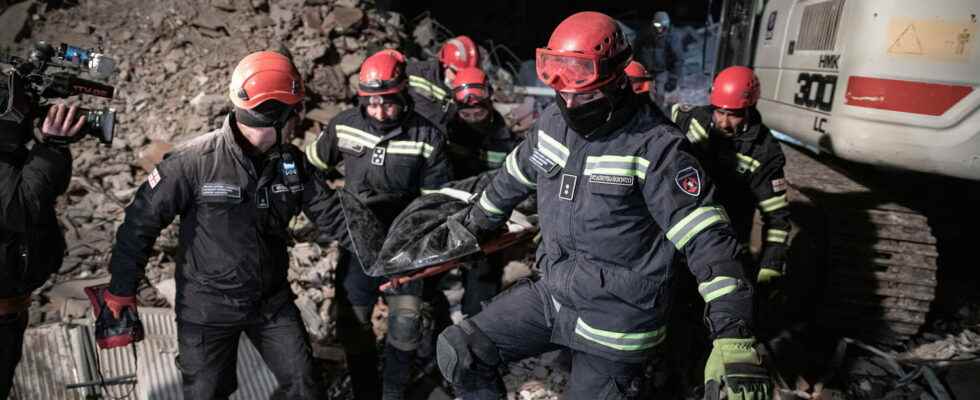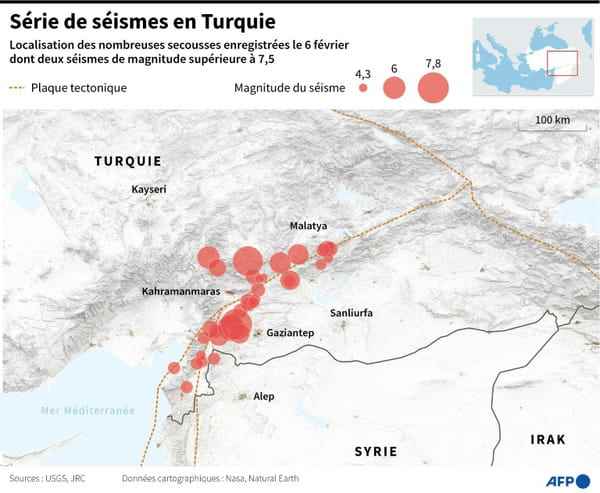TURKEY EARTHQUAKE. The earthquake in Turkey and Syria killed more than 21,000 people according to the latest official report of February 10. Rescue operations continue but rescues are more difficult and rarer.
The earthquake that shook Turkey and Syria on Monday February 6 was one of the most devastating in the last two decades. On February 10, five days after the earthquakes, the human toll continued to rise with more than 21,700 deaths counted in the two countries. This figure can still change, more than the number of victims injured or buried but saved. More than 60,000 people have been rescued but four days after the earthquake in Turkey the likelihood of finding other survivors is dwindling. The fault is the lack of water, sometimes the lack of air in the pockets of survival under the rubble, but also the numerous aftershocks and the freezing cold which reigns in south-eastern Turkey at this time of year. . Miraculous rescues of several people stuck for several hours or days, including children and sometimes newborns, still marked the spirits.
Turkish and Syrian rescuers, joined on February 7 by teams of international rescuers and humanitarian aid, continue their operations despite the difficulties. In Syria, where the intervention of the rescuers was slow, the first convoys of humanitarian aid arrived on the spot on February 9. The authorities could soon decide to end the interventions in favor of the operations to clear thousands of tons of rubble.
The rumblings of the Earth have done immense damage in Turkey but also in Syria. According to the latest official report released on Friday February 10, more than 21,700 people died as a result of the earthquakes, including 18,342 in Turkey and 3,377 in Syria. The number of injured has not been communicated but it amounts to at least more than 60,000 people. In addition to the physical victims of the earthquakes, the World Health Organization (WHO) estimates that 23 million people are at risk of being “potentially exposed” to the consequences of the earthquake in Turkey, “including around five million vulnerable people”. The same organization also fears that a major health crisis will occur after the natural disaster.
The damage is also material with several thousand buildings destroyed on both sides of the Turkish-Syrian border. More than 6,000 buildings and infrastructure collapsed during the earthquake or aftershocks in Turkey and that’s not counting the thousands of other cracked buildings that threaten to collapse in turn. The authorities plan in places to proceed with the voluntary destruction of the buildings to avoid making new victims.
Turkey has, in the hours following the earthquake, made security arrangements and mobilized all its rescuers, nearly 25,000 according to Afad, the official organization in charge of security. Turkish Interior Minister Süleyman Soylu has also issued a level four alert which involves a call for international assistance. Syria followed this example a few hours later.
Nearly fifty countries have come forward in the face of the emergency in Turkey and Syria. The first response was the dispatch of professional or volunteer rescue teams. The European Union was the first to provide humanitarian aid before several European nations followed suit. In addition to Europe and the United States, Ukraine and Russia, at war, have offered to send all “necessary aid”. As well as China via the Chinese foreign aid agency, India, Iran or Azerbaijan. In Israel, Prime Minister Benjamin Netanyahu “ordered all authorities to immediately prepare to provide medical assistance and relief” and “approved” the dispatch of aid to enemy country Syria.
After sending rescuers, financial funds are released to help the two countries affected by the earthquake. Washington released 85 million for Turkey and Syria. France has, for its part, planned to provide 12 million euros in emergency aid and London has released 4.3 million euros to help the intervention of peacekeepers.
The first earthquake in Turkey, that of magnitude 7.8, occurred in the district of Pazarcik, in the south-east of Turkey, located about sixty kilometers with the Syrian border and 17.9 kilometers deep according to the the American Institute of Geophysics (USGS). However, the force of the earthquake was felt even in neighboring countries such as Jordan, Lebanon and Cyprus.
A few hours later, the second earthquake started about a hundred kilometers from the epicenter of the first. With a magnitude of 7.5, the earthquake shook a large part of Anatolia: from Ankara and Diyarbakır, cities 670 kilometers apart from east to west, and from Malatya to Adana separated by 300 kilometers from north to south .

